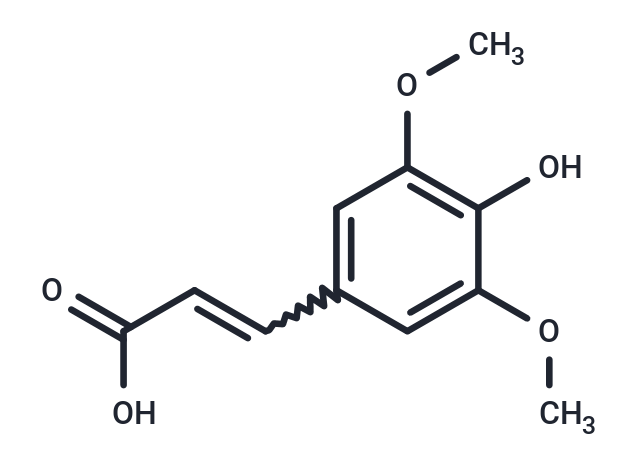 Your shopping cart is currently empty
Your shopping cart is currently empty

Sinapinic Acid (Synapoic acid) protects the rat liver from CCl4-induced inflammation, most likely by acting as a free radical scavenger and modulator of NF-κB p65 activation and proinflammatory cytokine expression. Sinapic acid with antioxidant role protects cardiac cells and its functions from I/R induced oxidative stress. Sinapic acid is a potentially useful agent for the protection against liver fibrosis and cirrhosis. Sinapic acid prevents the alterations in the levels of lipids and lipoproteins by virtue of its anti-lipidaemic effect in isoproterenol induced myocardial infarcted rats. Sinapic acid ameliorates hyperglycemia through PLC-PKC signals to enhance the glucose utilization in diabetic rats.

| Pack Size | Price | USA Warehouse | Global Warehouse | Quantity |
|---|---|---|---|---|
| 100 mg | $29 | In Stock | In Stock | |
| 1 mL x 10 mM (in DMSO) | $29 | In Stock | In Stock |
| Description | Sinapinic Acid (Synapoic acid) protects the rat liver from CCl4-induced inflammation, most likely by acting as a free radical scavenger and modulator of NF-κB p65 activation and proinflammatory cytokine expression. Sinapic acid with antioxidant role protects cardiac cells and its functions from I/R induced oxidative stress. Sinapic acid is a potentially useful agent for the protection against liver fibrosis and cirrhosis. Sinapic acid prevents the alterations in the levels of lipids and lipoproteins by virtue of its anti-lipidaemic effect in isoproterenol induced myocardial infarcted rats. Sinapic acid ameliorates hyperglycemia through PLC-PKC signals to enhance the glucose utilization in diabetic rats. |
| Targets&IC50 | HDAC:2.27 mM |
| Synonyms | Synapoic acid, Sinapic acid |
| Molecular Weight | 224.21 |
| Formula | C11H12O5 |
| Cas No. | 530-59-6 |
| Smiles | O(C)C1=C(O)C(OC)=CC(C=CC(O)=O)=C1 |
| Relative Density. | 1.307 g/cm3 |
| Color | Yellow |
| Appearance | Solid |
| Storage | Powder: -20°C for 3 years | In solvent: -80°C for 1 year | Shipping with blue ice/Shipping at ambient temperature. | |||||||||||||||||||||||||||||||||||
| Solubility Information | Chloroform, Dichloromethane, Ethyl Acetate, Acetone, etc.: Soluble H2O: < 1 mg/mL (insoluble or slightly soluble) DMSO: 40 mg/mL (178.4 mM), Sonication is recommended. | |||||||||||||||||||||||||||||||||||
| In Vivo Formulation | 10% DMSO+40% PEG300+5% Tween 80+45% Saline: 2 mg/mL (8.92 mM), Sonication is recommended. Please add the solvents sequentially, clarifying the solution as much as possible before adding the next one. Dissolve by heating and/or sonication if necessary. Working solution is recommended to be prepared and used immediately. The formulation provided above is for reference purposes only. In vivo formulations may vary and should be modified based on specific experimental conditions. | |||||||||||||||||||||||||||||||||||
Solution Preparation Table | ||||||||||||||||||||||||||||||||||||
DMSO
| ||||||||||||||||||||||||||||||||||||
| Size | Quantity | Unit Price | Amount | Operation |
|---|

Copyright © 2015-2025 TargetMol Chemicals Inc. All Rights Reserved.